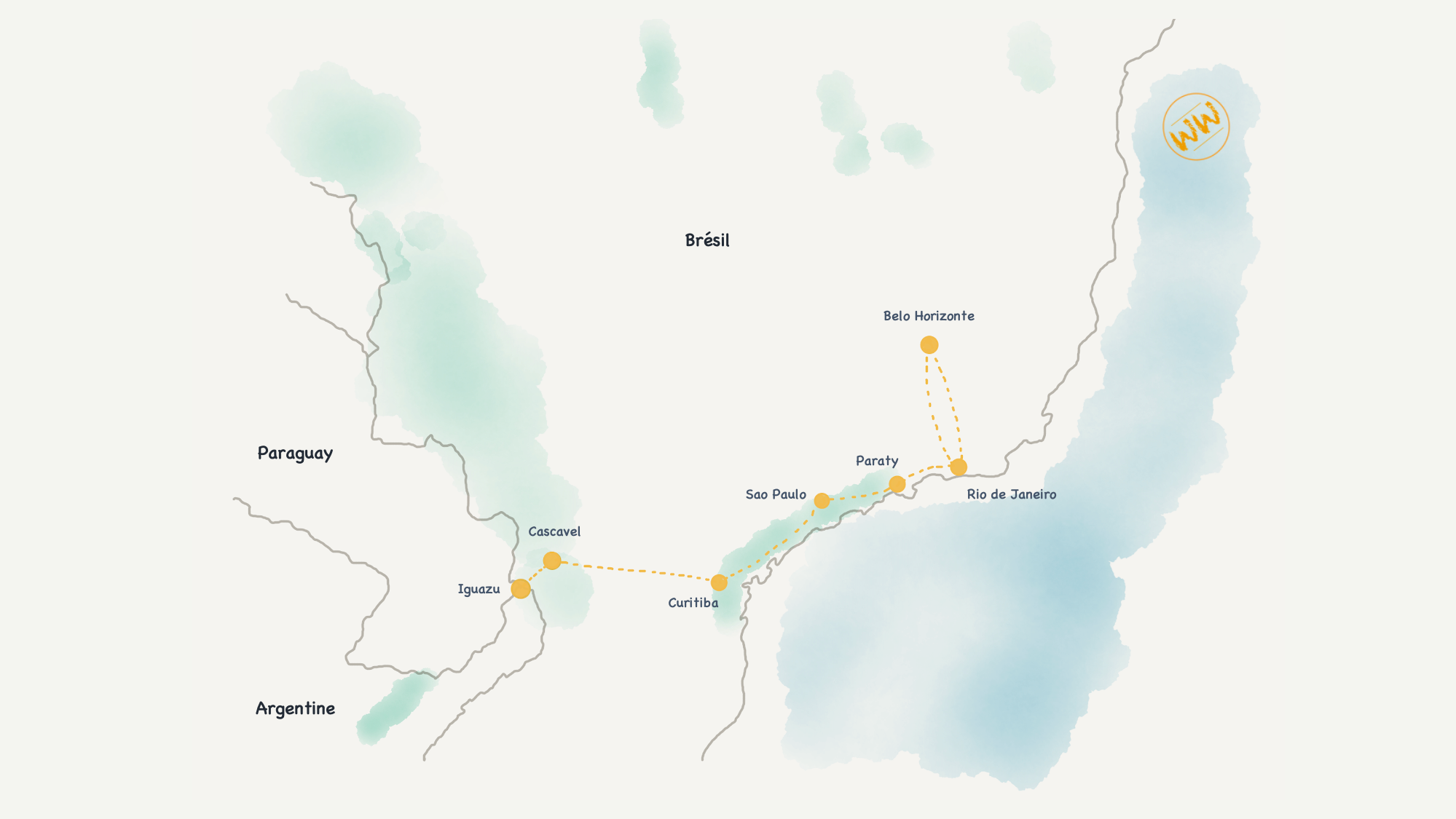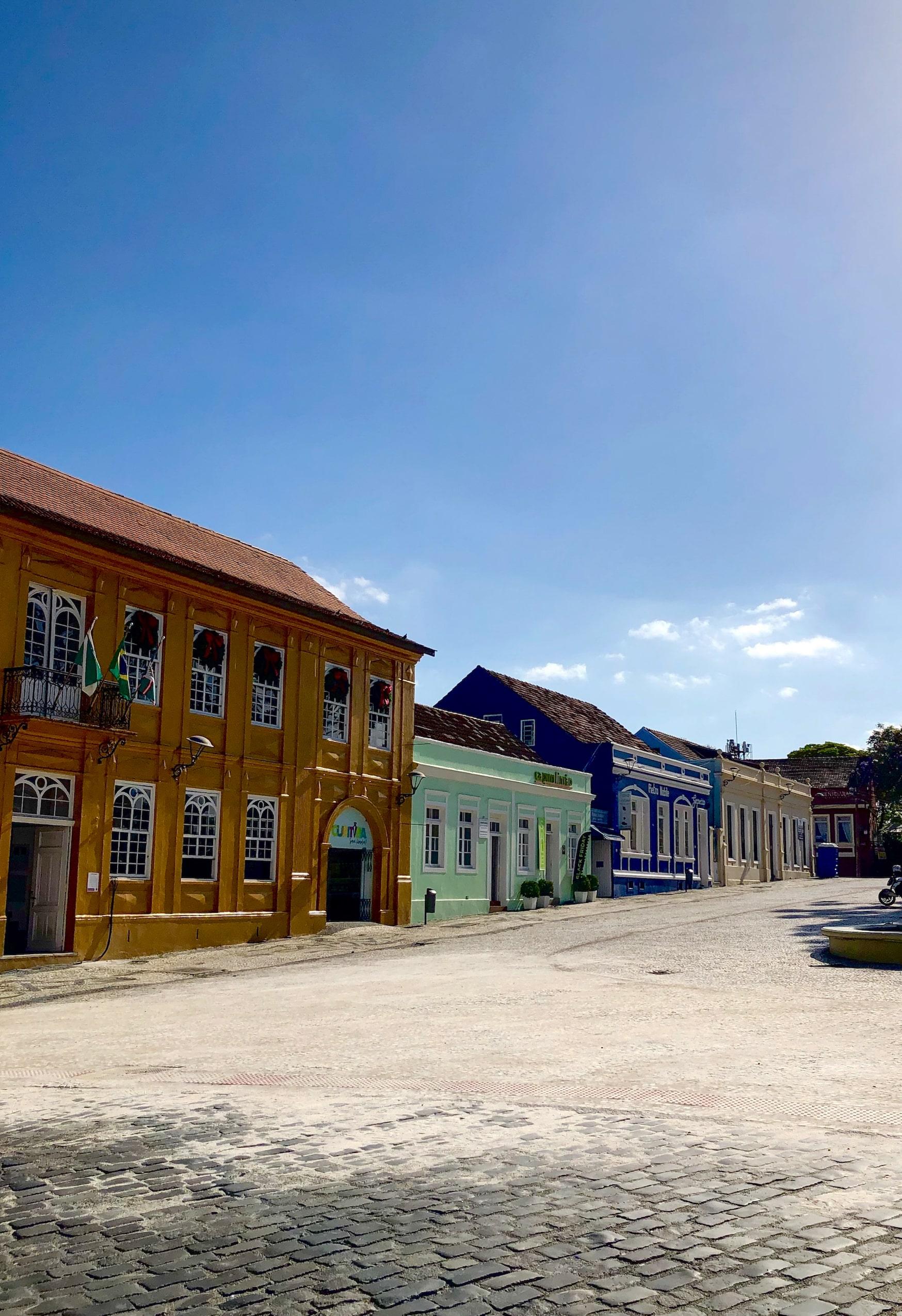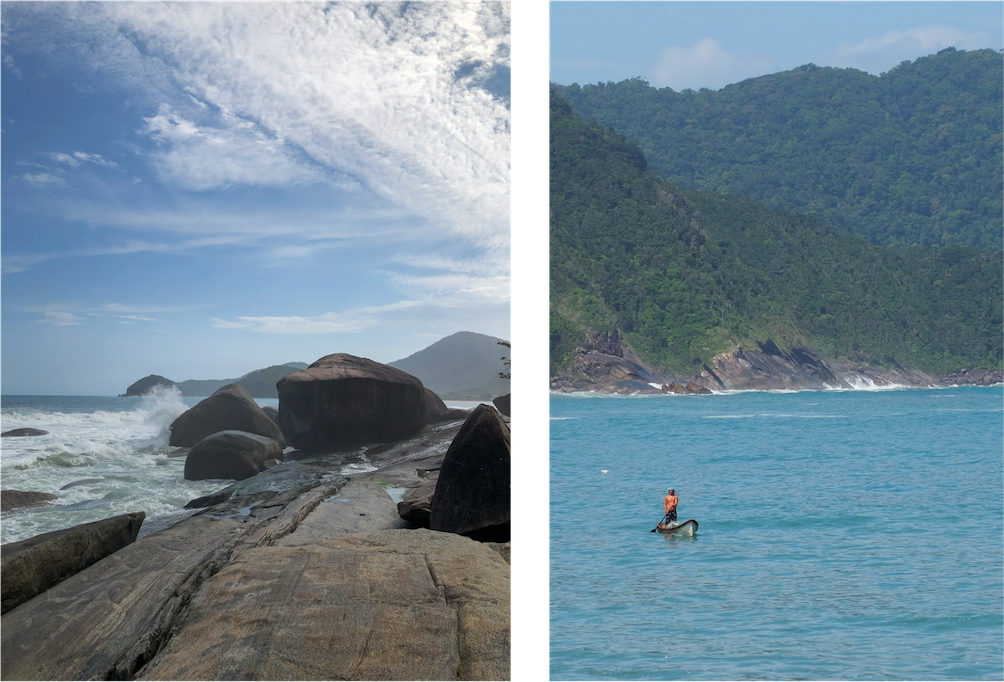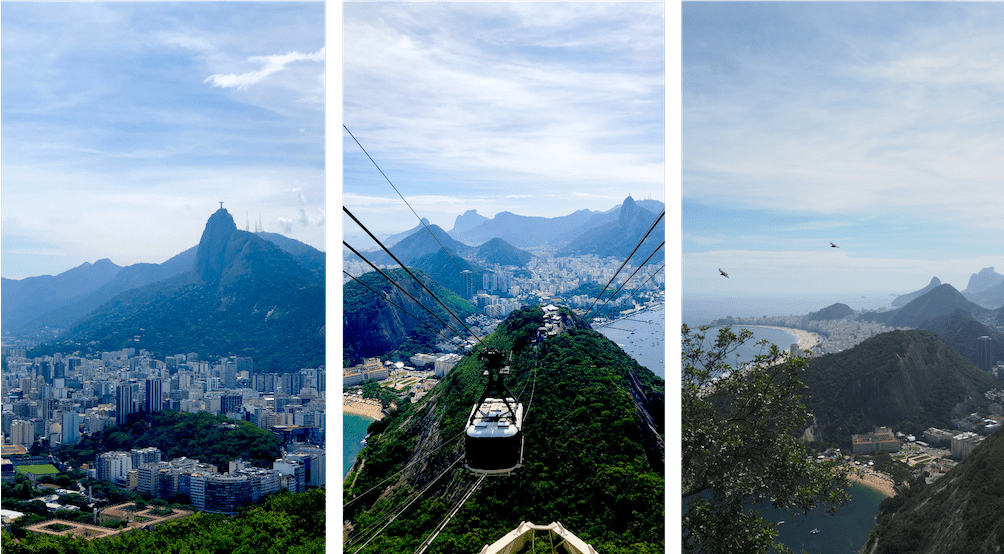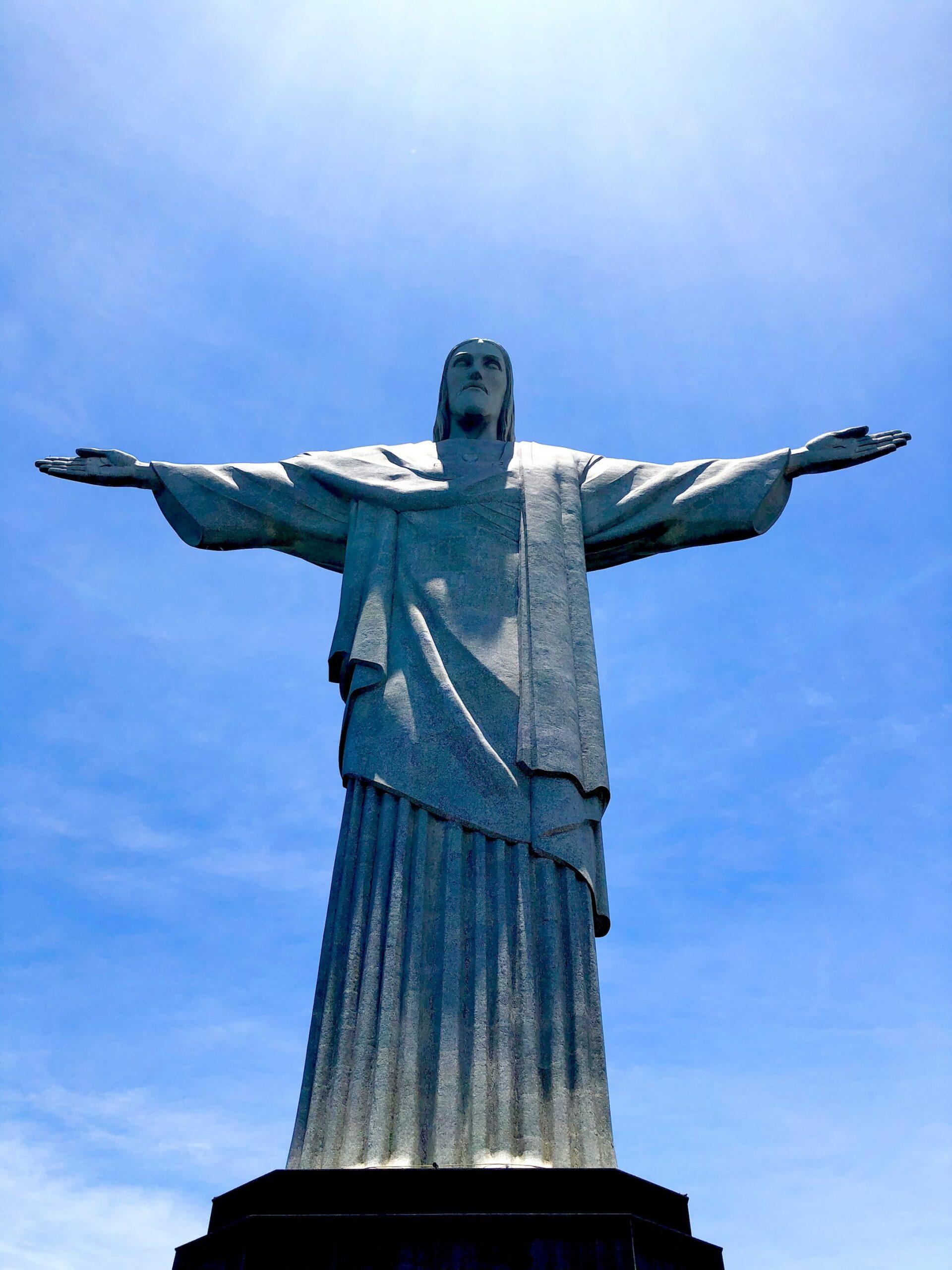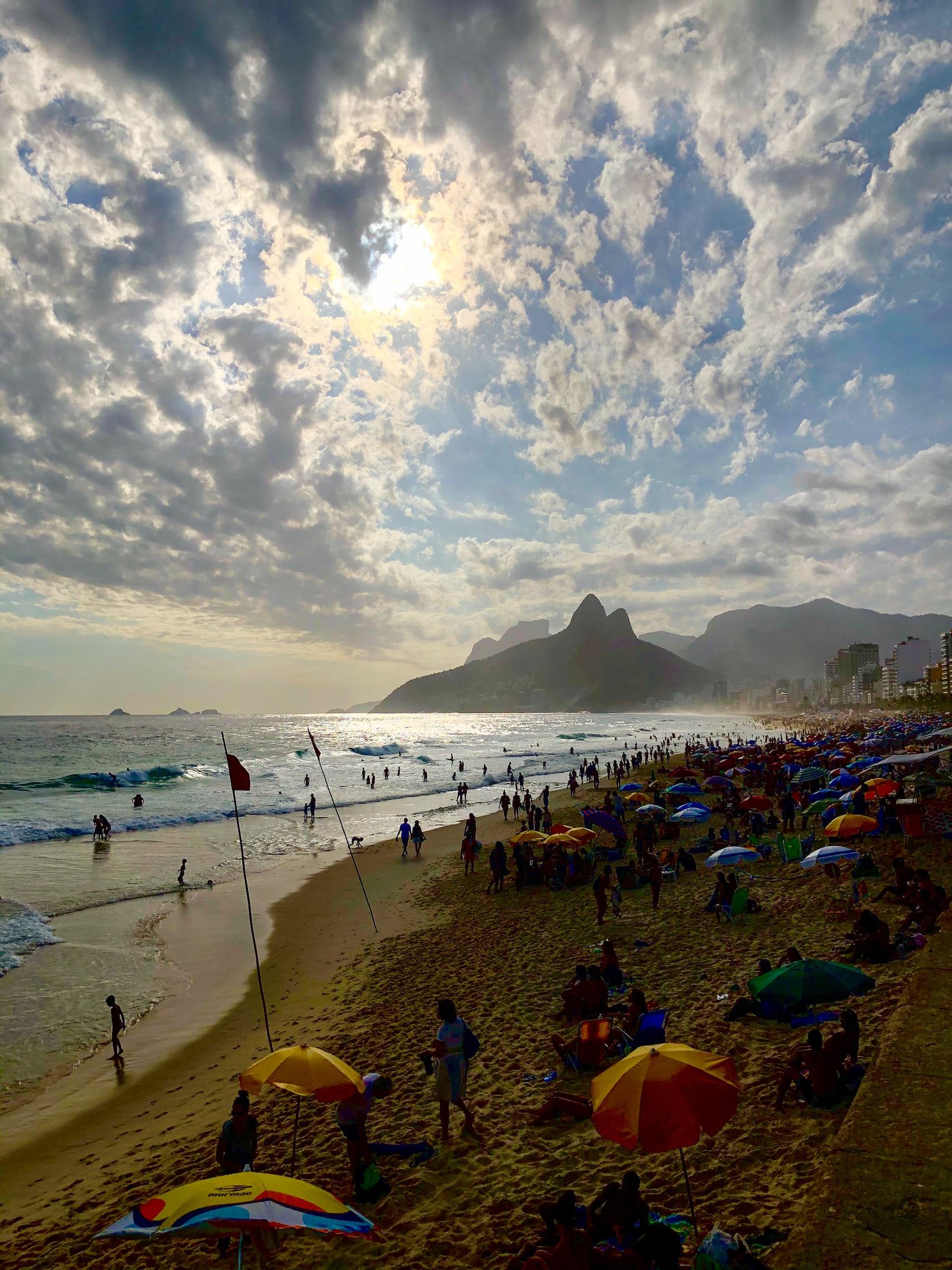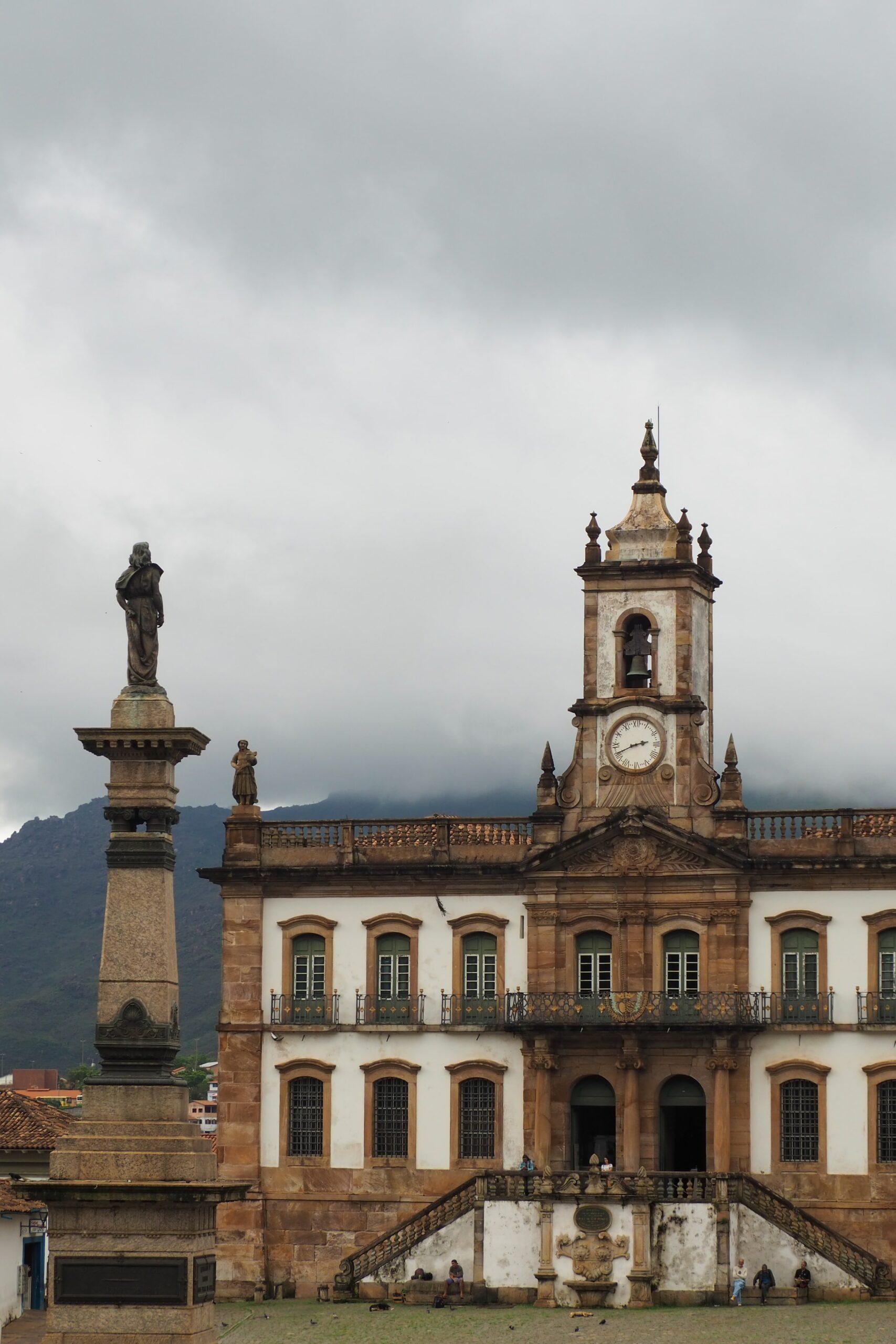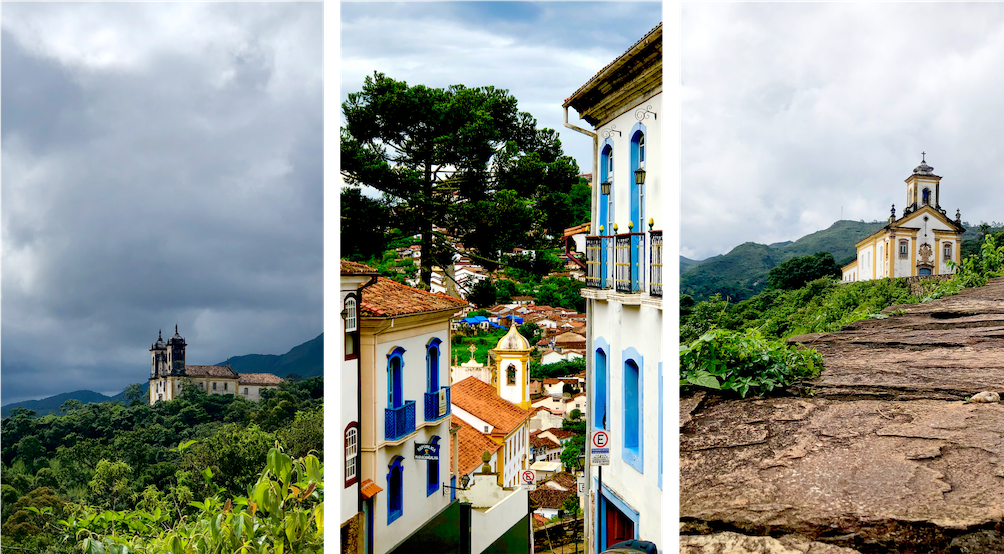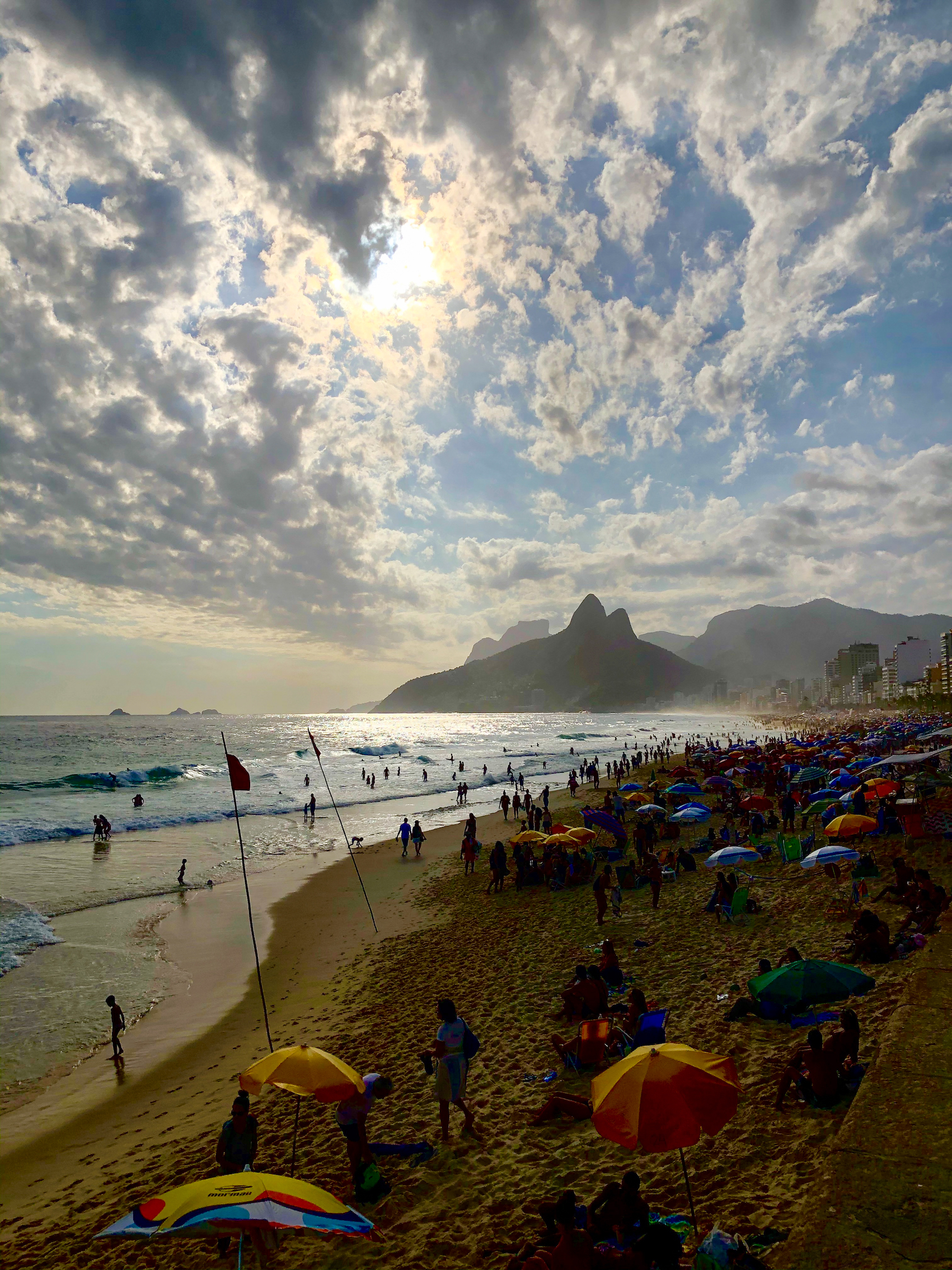Temps de lecture : 5 minutes
Les chutes d’Iguazu marquent la fin de notre périple argentin. Il est temps de découvrir le Brésil, notre dernier pays en Amérique du Sud.
Nous vous détaillons dans cet article notre trajet par la route, d’Iguazu à Rio de Janeiro. Notre article est assez court car une fois sur place, nous avons réalisé n’avoir peut-être pas fait le meilleur choix en terme d’itinéraire. Vous trouverez néanmoins tous les détails nécessaires pour faire votre trajet en fonction de vos envies.
NOTRE VOYAGE : 21 jours sur place, du 25 novembre au 15 décembre 2019
OÙ ? Brésil
DÉCALAGE HORAIRE : -4h en hiver, -5h en été
MONNAIE : Brazilian Real (BRL) : 1€ = 6 BRL en décembre 2020.
SE DÉPLACER : On vous conseille de louer une voiture pour être libres de vos mouvements. Nous sommes passés par Movida mais il existe d’autres loueurs.
POURQUOI Y ALLER ? Pour la côte atlantique, les plages de Rio, son Corcovado, son Pain de Sucre !
ACCESSIBILITÉ : Retrouvez toutes nos adresses sur notre carte Mapstr !
Étape 1 : Iguazu - Curitiba (4 jours, 3 nuits)
Nous quittons Iguazu pour découvrir la Costa Verde de l’intérieur. Nous passons une nuit d’étape à Cascavel avant d’arriver à Curitiba. Le centre ville mérite de s’y arrêter. Nous flânons sur le marché de Noël de la Praça Osório. Quelques rues plus loin, nous arrivons sur une place entièrement colorée où a régulièrement lieu la Feira do Largo da Ordem, une foire qui s’étend dans les rues piétonnes adjacentes.
Movida : Nous louons une voiture à l’aéroport d’Iguazu côté brésilien pour toute la durée de notre séjour.
Ibis Cascavel : Nous faisons étape à Cascavel dans cet hôtel. Accessibilité : les services de l’hôtel sont tous bien accessibles.
Novotel Curitiba : Un superbe hôtel récemment rénové. Accessibilité : la chambre est bien aménagée à l’exception du mitigeur de la douche installé sur le même mur que le banc.
Largo’s Bar : Entre deux rues piétonnes, prenez une bière et quelques tapas au soleil ! Accessibilité : seule la terrasse est accessible.
Étape 2 : São Paulo (1 jour, 2 nuits)
Nous arrivons un samedi soir à São Paulo. Malheureusement, notre calendrier ne nous a pas laissé de choix à ce niveau là. Si vous prévoyez de vous y arrêter pendant votre séjour, essayez de le faire en semaine pour que la ville soit plus vivante.
Nous déambulons ainsi dans des rues vides. Nous passons ainsi devant l’imposante Cathédrale de São Paulo juste à côté de la Praça da Sé. Entre deux averses, nous nous réfugions dans les quelques magasins ouverts. Nous remonterons jusqu’au marché municipal pour y déjeuner. Vous avez l’embarras du choix en terme de repas. On a choisi par hasard le Picanharia Mercadão (Rua I, Box 31) qui s’est révélé être très bon !
Sur le chemin du retour, nous nous sommes attardés sur l’Avenida Paulista. Elle devient piétonne chaque dimanche.
Mercure Sao Paulo Alamedas : Nous l’avons choisi pour son emplacement non loin du centre ville. Accessibilité : la chambre PMR est grande et bien aménagée. L’accès PMR se fait par le parking de l’hôtel.
Capim Santo : Un très bon restaurant à deux pas de l’hôtel. Nous avons opté pour une dégustation afin de découvrir les plats typiques du Brésil. Accessibilité : l’entrée est à plat et les toilettes sont accessibles.
Étape 3 : Paraty (4 jours, 3 nuits)
Nous rejoignons la côte à Paraty. Cette ville était à son apogée au temps des colons portugais. Son port avait été sélectionné pour entreposer et charger l’or provenant de la région du Minas Gerais dont fait partie Ouro Preto.
Les bateaux arrivaient du Portugal à vide, uniquement lestés de plusieurs tonnes de pierres. Une fois déchargés, ils repartaient pleins d’or pour le continent. Ces pierres ont permis aux habitants de Paraty de façonner les rues de la vieille ville. On ne va vous mentir, il faut de bonnes chaussures ou de bonnes roues de fauteuil pour les arpenter. Aucune pierre n’a été posée à plat pour faciliter la circulation !
Remontez jusqu’au port de plaisance en empruntant une passerelle au-dessus de la mer (une marche pour y accéder) pour avoir une petite vue sur la vieille ville.
À l’ouest de Paraty, un lieu bien connu des locaux vaut le détour. La Cascade du Tobogan est une zone de baignade parsemé de petites cascades. Venez vous aussi essayer de surfer sur l’eau filant à toute vitesse sur la roche.
Enfin, au sud de Paraty, la ville de Trindade a tout d’un petit village de bord de mer. De nombreux restaurants de poissons donnent sur la plage de sable fin.
Pousada Villa Harmonia : À quelque minutes du centre ville, cette pousada est au calme. Accessibilité : la chambre accessible est bien aménagé. Deux inconvénients : elle est humide et peu éclairée.
Paraty
Bem Brasil : Sirotez une caipirinha en terrasse.
Casa do Fogo : Restaurant typique de Paraty. Il y a souvent de la musique live. Accessibilité : Deux marches à l’entrée et toilettes pas accessibles.
Margarida Café : Une des adresses les plus connues de Paraty ! Accessibilité : une marche à l’entrée.
Trindade
Canto da Lua : La terrasse sur la plage vaut le détour. Accessibilité : entrée à plat et toilettes accessibles.
Étape 4 : Rio de Janeiro (4 jours, 5 nuits)
Ça y est ! Nous sommes à Rio, l’avant-dernière étape de nos trois mois en Amérique du Sud ! Depuis notre arrivée au Brésil, nous attendons avec impatience la découverte de cette ville emblématique.
Pour visiter plus aisément les différents lieux touristiques, nous vous conseillons de conserver votre voiture de location un jour ou deux supplémentaires. Si vous ne pouvez pas, sachez que tous les bus de la ville sont accessibles en fauteuil roulant.
Nous commençons notre visite par le Pain de Sucre, ce morne de près de 350 mètres de haut. Un téléphérique a été aménagé pour s’y rendre. La vue sur la baie est splendide et on peut même apercevoir le Christ Rédempteur dominant la ville.
Après nous être perdus sur le chemin du Corcovado, nous voila enfin au point de départ du train. Nous sommes assaillis par de nombreux guides qui nous proposent de nous emmener directement en haut pour éviter la queue. N’hésitez pas à résister à leurs propositions notamment si vous avez réservé votre train (à minima 24h à l’avance). Grimpez dedans et profitez de la balade. Entre les arbres, vous pouvez avoir un aperçu de ce qui vous attend en haut. Les portes s’ouvrent, faites quelques mètres et le Christ Rédempteur apparait. Cette statue de 38 mètres de haut, devenue iconique depuis sa construction en 1931, domine la ville. Le panorama est à couper le souffle !
Le lendemain, nous décidons de visiter le centre ville. Depuis l’hôtel, nous avons pris un taxi jusqu’à l’escalier Selarón. L’endroit est très prisé des touristes à juste titre. Il est entièrement recouvert de céramique de toutes les couleurs. Pour nos lecteurs en fauteuil, malheureusement il n’y a pas d’endroit réellement accessible pour le voir.
Notre balade nous mène jusqu’au Musée de Demain (Museu do Amanhã) en passant à côté du théâtre municipal.
Malgré le tumulte d’une ville de cette taille, se promener à pied n’est pas un problème. Nous rentrons par la plage de Copacabana où les échoppes des vendeurs de poissons grillés, d’açai et de noix de coco se succèdent.
Nous terminons la visite de la ville par le Fort de Copacabana, juste devant notre hôtel. Entièrement au calme, cet endroit est parfait pour se balader le dimanche en famille ou entre amis. Il offre une superbe vue (non accessible) sur Copacabana. Profitez de l’un des restaurants pour bruncher copieusement avant d’aller sur la plage ! On vous conseille de terminer votre journée par un coucher de soleil sur Ipanema, l’un des plus beaux de notre séjour au Brésil !
Fairmont Copacabana : Entre les plages de Copacabana et d’Ipanema, vous ne pouvez pas le rater ! Prenez en plein la vue dans la piscine à débordement au 6ème étage donnant sur la baie de Rio ! Une des meilleures vue ! Le cocktails et restaurants sont délicieux ! On craque pour le petit déjeuner ! Accessibilité : Toute l’équipe se fera un plaisir de vous aider pour accéder aux différents services (Spa, salle de sport, piscine…), n’hésitez pas à leur demander.
Café 18 do Forte : Au coeur du Fort de Copacabana, prenez un brunch en terrasse à l’ombre des arbres ! Pensez à réserver, c’est souvent complet ! Accessibilité : seule la terrasse est accessible.
Nous avions diné au restaurant Zuka mais il a malheureusement fermé. Nous n’avions pas eu le temps de les tester mais on nous avait recommandé le Nosso et le Zazá Bistrô au coeur d’Ipanema.
Enfin, si vous voulez une glace à tomber, foncez chez Vero !
Pao de Azucar : Deux téléphériques vous emmènent en haut du Pain de Sucre pour profiter d’une vue à couper le souffle ! Tarifs : R$114 par personne, R$57 pour les PMR et leur accompagnant. Accessibilité : Le téléphérique est entièrement accessible y compris les toilettes. Vous montez en premier avec votre accompagnant.
Corcovado : Grimpez dans le train à crémaillère pour découvrir cette nouvelle merveille du monde ! Tarifs : R$88 (saison haute) ou R$71 (saison basse) pour le train par personne. Il faut absolument réserver en ligne. Des guides vous proposent également de monter et de sauter la file d’attente mais il vous en coutera R$95 par personne. Enfin un service de minibus est également disponible pour R$80 par personne. Accessibilité : Le train est entièrement accessible. Une fois en haut il y a deux escalators pour lesquels une employé du parc vous aide.
Fort de Copacabana : Découvrez le fort sous toutes les coutures. Tarifs : R$6 par personne, gratuit PMR et accompagnant. Accessibilité : Entièrement accessible y compris les toilettes.
Plage de Copacabana : Tout le long de la plage, de nombreuses toilettes accessibles sont disponibles.
Étape 6 : Belo Horizonte - Ouro Preto (2 jours, 3 nuits)
Nous quittons Rio de Janeiro pour nous enfoncer dans l’arrière pays en direction de Belo Horizonte. La route est longue entre les deux villes et il y a peu d’endroits pour s’arrêter. Nous avons ajouté cette dernière étape à notre périple dans le but de nous rapprocher de la ville minière d’Ouro Preto.
C’est ici que les colons portugais venaient récupérer l’or pour charger leurs navires. Leur influence se ressent jusque dans l’architecture des bâtiments un peu partout dans la ville.
Le centre ville tient en quelques rues autour de la Praça Tiradentes :
- Au sud, le Musée de l’Inconfidence (accessible en fauteuil) retrace l’histoire de la rébellion menée par Tiradentes, premier défenseur d’un gouvernement indépendant du Portugal. Quelques rues plus loin, l’Église Saint-François d’Assise est un des trésors baroque de la ville.
- Au nord de la place, remontez la rue en direction de l’Igreja de Nossa Senhora das Mercês e da Misericórdia. De là, vous aurez une belle vue sur l’ensemble de ces bâtiments coloniaux. Juste à côté, le Musée des Sciences et de la Technologie permet d’en apprendre plus sur l’extraction minière. Il est malheureusement inaccessible en fauteuil.
Ibis Belo Horizonte : L’hôtel est composé de deux bâtiments. La réception se trouve dans une ancienne maison du début du siècle. Les chambres sont dans la partie la plus récente. Accessibilité : seul le petit-déjeuner est difficile d’accès. Le service se fait au premier étage de l’ancienne maison mais l’équipe vous apporte avec plaisir ce que vous voulez.
Belo Horizonte
Yes – Nós Temos Café : L’endroit parfait pour un brunch avec comme son nom l’indique du très bon café ! Accessibilité : entièrement accessible et toilettes aménagées.
Ouro Preto
Chopp Real : Juste à côté de la Praça Tiradentes, avalez un bon petit plat avant de repartir à l’assaut des pavés ! Accessibilité : seule la terrasse est accessible.
Ouro Preto
Armazaem Rural : Cette petite boutique propose des bières et du café artisanal. Retrouvez aussi des poteries faites main juste derrière l’entrée principale. Accessibilité : il y a une marche pour entrer.
Étape 7 : Rio de Janeiro, suite et fin (1 jour, 2 nuits)
Pour notre dernière journée, nous décidons de prendre notre temps. Après une matinée piscine à l’hôtel, nous partons visiter le quartier de Santa Teresa. Assez petit mais totalement dans son jus, on se laisse charmer par les vendeurs d’artisanat local.
Nous passons la soirée au Portella où une chanteuse de Bossa Nova nous emporte loin de notre blues du retour à Paris.
MGallery Santa Teresa : Dans les hauteurs de Rio, cet hôtel est un havre de paix. Profitez de la piscine et de ses merveilleux cocktails à la tombée du soir, parfait ! Accessibilité : il y a deux chambres accessibles. Le restaurant n’est pas accessible mais le room service est possible.
Portella : À deux pas du MGallery Santa Teresa, commandez un mix d’entrées et vous ne serez pas déçus ! Les concerts live sont fréquents, n’hésitez pas à leur demander en passant devant ! Accessibilité : il y a une marche d’une vingtaine de cm pour entrer.
C’est ainsi que s’achèvent ces 3 mois et demi de voyage à travers l’Amérique du Sud. Nous allons récapituler l’ensemble de nos trajets dans un article de synthèse pour que vous retrouviez toutes les informations pratiques pour vous aussi organiser un voyage comme le notre !

